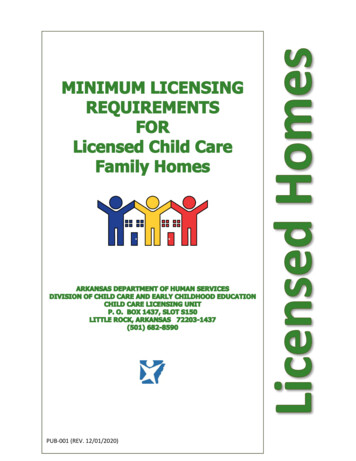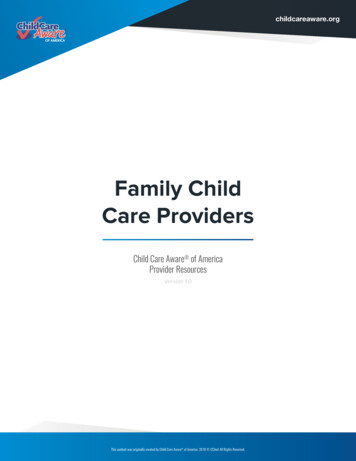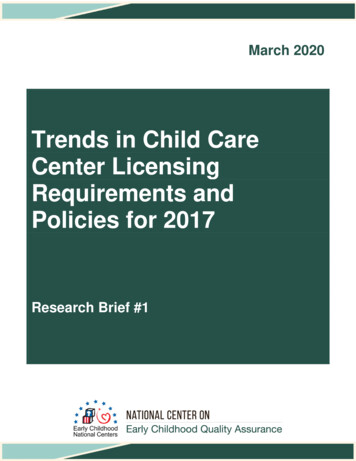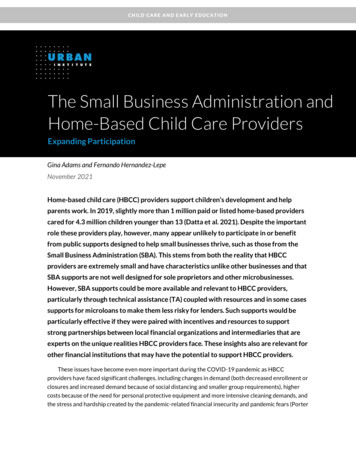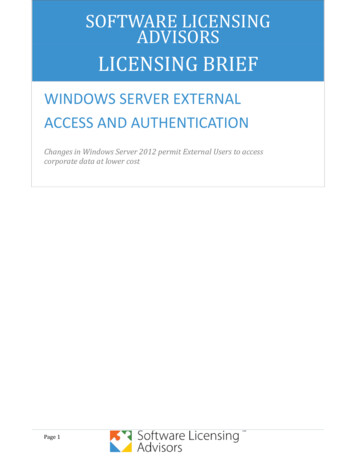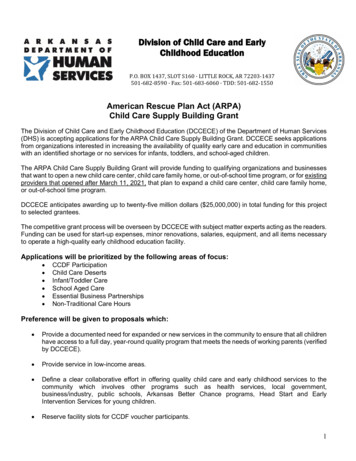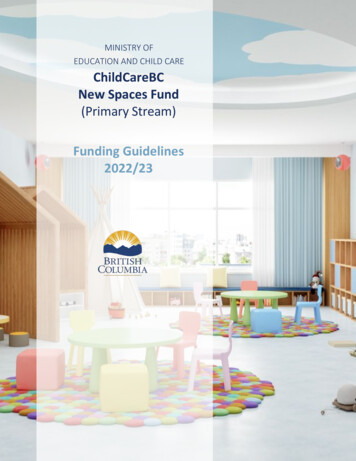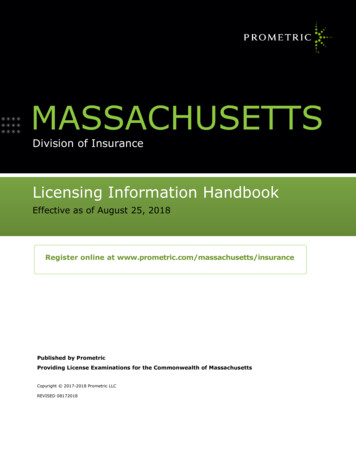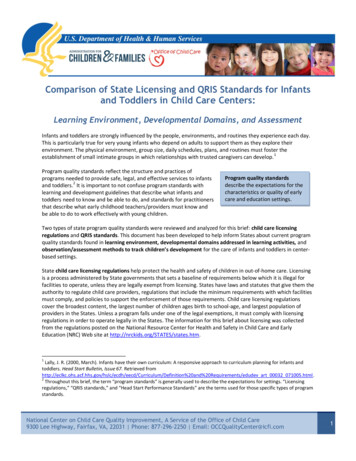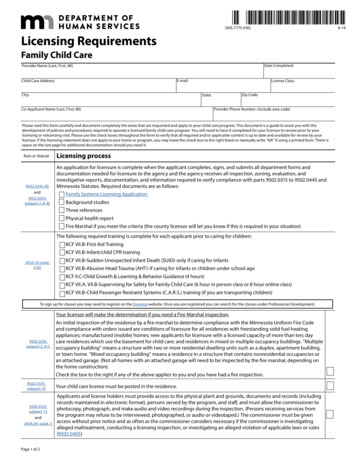
Transcription
Clear Form *DHS-7775-ENG*DHS-7775-ENG8-19Licensing RequirementsFamily Child CareDate Completed:Provider Name (Last, First, MI)E-mail:Child Care Address:City:License Class:Zip Code:State:Co-Applicant Name (Last, First, MI)Provider Phone Number: (include area code)Please read this form carefully and document completely the areas that are requested and apply to your child care program. This document is a guide to assist you with thedevelopment of policies and procedures required to operate a licensed family child care program. You will need to have it completed for your licensor to review prior to yourlicensing or relicensing visit. Please use the check boxes throughout the form to verify that all required and/or applicable content is up to date and available for review by yourlicensor. If the licensing statement does not apply to your home or program, you may leave the check box to the right blank or manually write “NA” if using a printed form. There isspace on the last page for additional documentation should you need it.Rule or Statute9502.0345 (B)and9502.0355subpart 2 (A,B)Licensing processAn application for licensure is complete when the applicant completes, signs, and submits all department forms anddocumentation needed for licensure to the agency and the agency receives all inspection, zoning, evaluation, andinvestigative reports, documentation, and information required to verify compliance with parts 9502.0315 to 9502.0445 andMinnesota Statutes. Required documents are as follows:Family Systems Licensing ApplicationBackground studiesThree referencesPhysical health reportFire Marshal if you meet the criteria (the county licensor will let you know if this is required in your situation)The following required training is complete for each applicant prior to caring for children:KCF VII.B-First Aid TrainingKCF VII.B-Infant/child CPR training245A.50 subd.2 (b)KCF VII.B-Sudden Unexpected Infant Death (SUID)-only if caring for infantsKCF VII.B-Abusive Head Trauma (AHT)-if caring for infants or children under school ageKCF II.C-Child Growth & Learning & Behavior Guidance (4 hours)KCF VII.A, VII.B-Supervising for Safety for Family Child Care (6 hour in person class or 8 hour online class)KCF VII.B-Child Passenger Restraint Systems (C.A.R.S.) training (if you are transporting children)To sign up for classes you may need to register on the Develop website. Once you are registered you can search for the classes under Professional Development.Your licensor will make the determination if you need a Fire Marshal inspection.9502.0335subpart 2, A,CAn initial inspection of the residence by a fre marshal to determine compliance with the Minnesota Uniform Fire Codeand compliance with orders issued are conditions of licensure for all residences with freestanding solid fuel heatingappliances; manufactured (mobile) homes; new applicants for licensure with a licensed capacity of more than ten; daycare residences which use the basement for child care; and residences in mixed or multiple occupancy buildings. “Multipleoccupancy building” means a structure with two or more residential dwelling units such as a duplex, apartment building,or town home. “Mixed occupancy building” means a residence in a structure that contains nonresidential occupancies oran attached garage. (Not all homes with an attached garage will need to be inspected by the fre marshal, depending onthe home construction).Check the box to the right if any of the above applies to you and you have had a fre inspection.9502.0335,subpart 109502.0335subpart 13and245A.04, subd. 5Page 1 of 2Your child care license must be posted in the residence.Applicants and license holders must provide access to the physical plant and grounds, documents and records (includingrecords maintained in electronic format), persons served by the program, and staf, and must allow the commissioner tophotocopy, photograph, and make audio and video recordings during the inspection. (Persons receiving services fromthe program may refuse to be interviewed, photographed, or audio or videotaped.) The commissioner must be givenaccess without prior notice and as often as the commissioner considers necessary if the commissioner is investigatingalleged maltreatment, conducting a licensing inspection, or investigating an alleged violation of applicable laws or rules(9502.0405)
For Licensor Use Only:Capacity, ratio, age distributionNote: The use of a substitute caregiver is limited to a total of not more than 500 hours annually. You must document the name, dates andnumber of hours of the substitute who provided care. Your licensor will need to review this at visits.Will/are you caring for infants?9502.0315,subpart 29(A)and 9502.0365,subpart 5YesNoThe caregiver must be within sight or hearing of an infant, toddler, or preschooler at all times, so that the caregiver iscapable of intervening to protect the health and safety of the children in care.The caregiver is required to be available for assistance and care of school age children in care.The person(s) on the license is the primary caregiver in the residence.If there is a second adult working with you in the child care, please list their name(s) here9502.0365,subpart 5If you have a second adult caregiver (18 years of age and older), this person has completed the required training and hashad a background study. Have documentation available for your licensor9502.0355,subpart 1,2A substitute must be at least 18 years old and have completed required training and have a background study on fle withthe agency. Have documentation available for your licensor9502.0315,subpart 14and245A.50(1,b)If you are using a helper in your child care they must be between the ages of 13 and 17 years old, have a back backgroundstudy and have completed the required Sudden Unexpected Infant Death (SUID) and/or Abusive Head Trauma (AHT),SUID is required if caring for infants and AHT is required if caring for children under school age. Have documentationavailable for your licensorReporting to agency9502.0375,subpart 2 CAll fres that require the service of a fre department must be reported to your licensor within 48 hours.List the date of any fres:Serious injury is one that requires treatment from a doctor and must be reported immediately after the occurrence.9502.0375,subpart 2 DList the dates of any serious injuries or deaths:9502.0375,subpart 2 BSuspected cases of physical or sexual abuse or neglect and must be reported immediately.9502.0375,subpart 2AContact your licensor immediately if a serious injury or death occurs during child care hours(Dates)List dates of any reported cases of sexual abuse or neglect:Providers must notify licensor within 30 days of any changes to the membership of the household. List the dates anymembers of your household moved in or out:List all members of your household and their ages:245C.20You are required to document the date you initiated a background study (BGS) on a new caregiver and household memberand the date the new caregiver has direct contact with persons served by the program in their personnel fle.Be prepared to have documentation for all initiated BGS. Dates for any:Page 2 of 2
Behavior guidanceDescribe the type of behavior guidance used with the children in your care:Infants:Toddlers:9502.0395,subpart 1 and 2Preschoolers:School Age:Review the following statements regarding behavior guidance and check the appropriate box at the end of the section.-Corporal punishment (physical discipline) is not allowed with the children in care. This includes, but is not limited to roughhandling, shoving, hair pulling, ear pulling, shaking, slapping, kicking, biting, pinching, hitting, and spanking-Emotional or psychological abuse of the children in care is not allowed. This includes but is not limited to name calling,ostracism, shaming, derogatory remarks about the child or child’s family, threats that threaten, humiliate or frighten the child-Food, light warmth, clothing or medical care shall not be withheld from a child9502.0395,subpart 2 (Athrough H)-Discipline and punishment shall not be delegated to another child-The separation of a child from a group to guide behavior must be appropriate to the age of the child and circumstancesrequiring the separation-An infant shall not be separated from the group for disciplinary reasons-A child shall not be separated from the group for a period longer than 10 minutes-A child separated from the group must be placed in an area or separate room that is well lighted, free from hazards,ventilated and open to the view of caregivers-No child shall be placed in a locked room to separate the child from the group9502.0395,subpart 3 (A,B)-No child is to be punished for toileting accidentsI understand these statements and will abide by themI do not understand these statements and would like to discuss them with a licensorAdmissions, provider records & reporting245A.14,subdivision 14You are required to keep daily attendance records for each child for which you are reimbursed by a government programfor the care of children (such as: Child Care Assistance Program or Early Learning Scholarships but does not include theCACFP)Be prepared to show documentation to your licensorRecords for each child need to contain the following information and should be gathered from the parents prior to admissionto your program. You will need to keep this information up to date and on fle for each child in care.Signed and completed Admission and Arrangements form must be on fle and contain:Name and birthdate of childFull name of parents9502.0405subpart 4 (Athrough F)Home address, work address, phone numbers where parents may be reachedName, address, phone number of physician, dentist and hospital to be used for emergencies when parents cannot bereachedName, address, phone number of family emergency contact person(s)Names of all authorized people who are allowed to pick up the child(ren) from the homeEnrollment datesFinancial arrangementsInsurance notifcation specifed in part 9502.0355, subpart 4, 245A.152Page 3 of 2
Special instructions from the parent shall be obtained in writing and followed about toilet training, eating, sleeping ornapping, allergies, and any health problems.Immunization records must be kept in agreement with MN Statutes section 121A.15. The provider will request, update and keepon fle the dates of immunizations received by a child in regular attendance at the residence as follows:9502.0405subpart 4 (Athrough F)Infants (6 weeks through 11 months)every 6 monthsToddlers (1 year through 23 months)annuallyPreschooler (2 years through 4 years)every 18 monthsSchool Age (5 years through 10 years)every 3 yearsSigned written consent must be obtained in advance from the parent so the provider may authorize emergency medicalcare or treatment for the child. The consent may be used if the parent cannot be reached or is delayed in arriving. Gatherthis information on the Admission and Arrangements form.Written permission to transport children must be obtained form the parents if you will be transporting the child/ren and achild can only be released to a parent or a person authorized by the parent or legal guardian. This information is found onthe Admission and Arrangements form.You must provide a written notice to all parents or guardians of all children (prior to admission) stating whether or not you have liabilityinsurance. This statement is incorporated into the Admission & Arrangements form.MN Statute245A.152If you have continuous insurance coverage, you only need to provide notice to parents/guardians if the coverage lapses(ends) or changes. To do this, you must use the Family Child Care Liability Insurance Notice to Parents/Guardians formprovided by DHS.If you DO NOT have coverage you must provide an annual notice to parents/guardians that you do not carry any liabilityinsurance. To do this, you must use the Family Child Care Liability Insurance Notice to Parents/Guardians245A.14,subdivision 14For any child enrolled with CCAP the attendance records must include the child’s frst and last name and the time the childwas dropped of and the time the child was picked up each day.Provide documentation of the attendance records to your licensor.Your provider policy must be written, shared with the parents and agency. It must include the following:The ages and numbers of children in care in the residence;The hours and days of operation;Meals and snacks to be served;Labeling requirements for food brought from the child’s home;Sleeping and rest arrangements;Nondiscrimination practices to comply with subpart 6;Policies for the care of ill children, disease notifcation procedures, immunizations, and medicine permission policies;9502.0405subpart 3 A-PEmergency, fre, and storm plans and the monthly fre drill log;Seat belt and transportation plans and feld trip and transportation permission requirements;Fees;Termination and notice procedures;245A.04subd. 1,c&dPlans for a helper and substitute for emergencies, vacations, or holidays;The presence of pets in the residence;A complete copy of parts 9502.0315 to 9502.0445 (Rule 2);Insurance coverage; andAlcohol and drug policyGrievance procedure policyMaltreatment of Minors/Mandated Reporter Policy9502.0405subpart 4 A & CPage 4 of 2You must have Admissions and Arrangements and Immunization Records forms on fle for each child in your care. Moreclarifcation has been ofered in MN statute 121A.15 and this document from the MN Dept. of Health.DHS-XXXX-ENG X-17
Before admitting a child for care, the license holder must obtain information about any known allergy from the child’s parent orlegal guardian. The license holder must maintain current allergy information in each child’s record.The allergy information must includeA description of the allergySpecifc triggersMN Statute245A.51subdivision1(a,b)Avoidance techniquesSymptoms of allergic reactionProcedures for responding to an allergic reactionDoctor’s contact informationThe child’s allergy information must be documented on a form approved by the commissioner.Every caregiver at your facility must review the allergy information annually.Describe your methods of toilet training here:9502.0405subpart 4 B9502.0405,subpart 3 H and245A.51, subd.3(c)You are required to have an up to date Fire and Storm Drill Log that documents the date and time of drills. You may use theform provided by DHS.For Licensor Use Only:Activities and equipment9502.0415,subpart 1Day care activities must provide for the physical, intellectual, emotional, and social development of the child. The environmentmust facilitate the implementation of the activities. Activities must be scheduled indoors and outdoors, weather permitting; beappropriate to the developmental stage and age of the child; include active and quiet activity; and contain provider-directedand child-initiated activity.Newborn or infant activities9502.0415,subpart 4The provider shall hold the infant or newborn during bottle feedings until the child can hold its own bottle. Bottles must notbe propped. Respond to the infant or newborn’s attempts to communicate. Provide freedom of movement to the infant ornewborn during a large part of the waking day to the extent that safety and weather permits. The noncreeping child shallspend part of each day out of a crib or infant seat. The creeping infant or newborn shall have freedom to explore outsideof the crib or infant seat. Give the infant or newborn opportunity to stimulate the senses by providing a variety of activitiesand objects to see, touch, feel, smell, hear, and taste. Provide activities for the infant or newborn that develop the child’smanipulative and fne motor skills, self-awareness, and social responsiveness.Describe your Infant activities here:Page 5 of 2DHS-XXXX-ENG X-17
Toddler activities9502.0415,subpart 6The provider shall provide the toddler with freedom of movement and freedom to explore outside the crib or playpen. Talk to,listen to, and interact with the toddler to encourage language development. Provide the toddler with large muscle activitiesand activities which develop the child’s small muscles and manipulative skills. Develop and stimulate learning by readingstories to the child or looking at picture books together. Give the toddler opportunities to stimulate the senses by providing avariety of age-appropriate activities and objects to see, touch, feel, smell, hear, and taste.Describe your Toddler activities here:Preschooler activities9502.0415,subpart 8The provider shall encourage conversation between the child and other children and adults. Provide opportunity to play nearand with other children; provide time and space for individual and group play; allow for quiet times to talk or rest; allow forunplanned time and individual play time. Foster understanding of personal and peer feelings and actions and allow for theconstructive release of feelings and anger through discussion or play. Give assistance in toileting and provide time to carry outself-help skills and provide opportunity to be responsible for activities like putting away play equipment and helping aroundthe house. Provide opportunities for each child to make decisions about daily activities and to take credit for the consequencesof decisions. Provide time and areas for age appropriate large muscle play. Provide learning, small muscle, manipulative,creative or sensory activities. Read stories, look at books together, and talk about new words and ideas with the child.Describe your Preschool activities here:9502.0415,subpart 59502.0415,subpart 7 & 9Required Infant Equipment:Infant seat or high chair; and a crib, portable crib, or playpen with waterproof mattress or pad which meets therequirements in part 245A.146Required Toddler and Preschooler Equipment.Each toddler shall be provided with a mat, crib, cot, bed, sofa, or sleeping bag.School-age activities.9502.0415,subpart 10Provide time for one on one discussion about the day and planning for activities. Provide space for games and sports usingthe whole body, outdoors (weather permitting) and provide time for rest. Allow for increased freedom as responsibility isobserved. Provide group activities as well as individual self help skills. Ofer dramatic play and crafts.Describe your School-age activities here:9502.0415,subpart 12Written permission must be obtained from the parent to allow a school-age child in care to participate in activities away fromthe child care home.For Licensor Use Only:Page 6 of 2DHS-XXXX-ENG X-17
Cribs and Safe SleepReduction Of Risk Of Sudden Unexpected Infant Death In Licensed Programs.(a) When a license holder is placing an infant to sleep, the license holder must place the infant on the infant’s back, unless thelicense holder has documentation from the infant’s physician directing an alternative sleeping position for the infant. Thephysician directive must be on a form approved by the commissioner and must remain on fle at the licensed location. Aninfant who independently rolls onto its stomach after being placed to sleep on its back may be allowed to remain sleeping onits stomach if the infant is at least six months of age or the license holder has a signed statement from the parent indicatingthat the infant regularly rolls over at home.(b) The license holder must place the infant in a crib directly on a frm mattress with a ftted sheet that is appropriate to themattress size, that fts tightly on the mattress, and overlaps the underside of the mattress so it cannot be dislodged by pullingon the corner of the sheet with reasonable efort. The license holder must not place anything in the crib with the infant exceptfor the infant’s pacifer, as defned in Code of Federal Regulations, title 16, part 1511. The requirements of this section applyto license holders serving infants. Licensed child care providers must meet the crib requirements under section 245A.146. Acorrection order shall not be issued under this paragraph unless there is evidence that a violation occurred when an infant waspresent in the license holder’s care.MN Statute245A.1435and245A.146 and245A.147(c) If an infant falls asleep before being placed in a crib, the license holder must move the infant to a crib as soon as practicable,and must keep the infant within sight of the license holder until the infant is placed in a crib. When an infant falls asleep whilebeing held, the license holder must consider the supervision needs of other children in care when determining how long tohold the infant before placing the infant in a crib to sleep. The sleeping infant must not be in a position where the airway maybe blocked or with anything covering the infant’s face.(d) Placing a swaddled infant down to sleep in a licensed setting is not recommended for an infant of any age and is prohibitedfor any infant who has begun to roll over independently. However, with the written consent of a parent or guardian accordingto this paragraph, a license holder may place the infant who has not yet begun to roll over on its own down to sleep in a onepiece sleeper equipped with an attached system that fastens securely only across the upper torso, with no constriction of thehips or legs, to create a swaddle. Prior to any use of swaddling for sleep by a provider licensed under this chapter, the licenseholder must obtain informed written consent for the use of swaddling from the parent or guardian of the infant on a formprovided by the commissioner and prepared in partnership with the Minnesota Sudden Infant Death Center.Checklist for safe sleep for infantsPlace an infant to sleep on their backThe crib must have a frm mattress with a ftted sheetNothing can be placed in the crib other than the infant and the paciferSwaddling is not recommended but if done you must have written parental permissionAny other sleeping positions MUST have physician’s written orders (you are required to use the DHS form)You are encouraged to conduct in person checks every 30 minutes on a sleeping infant or every 15 minutes during the frstfour months of being in your childcareYou are encouraged to use an audio or visual monitoring device to monitor each sleeping infantMonthly safety inspections (DHS form) for every crib and mesh sided crib that are used or accessible to children in care isrequired and needs to be documented. In addition, documentation of the brand name and model number for each crib usedby or accessible to children in care is required. Annually you must check the crib brand name and model number against theUS Consumer Product Safety website.Physical environmentIndoor/Outdoor Space Was your home constructed before or after May 2, 2016? BeforeAfterThere must be at least 35 square feet of usable indoor space per child.9502.0425subpart 1ABathrooms, closets, space occupied by major appliances and other space NOT used by children CANNOT be counted inthis square footage, however space occupied by adult furniture that is used by children MAY be counted as usable indoorspace.If the basement is being used as part of your indoor space, you may need to have it inspected by the fre marshal.9502.0425subpart 1BIt must be free of hazard and must have 2 ways to safely escape. (9502.0425 subpart 4)Will you be using your basement space for child care?YesNoN/AThere must be an outdoor play space of at least 50 square feet per child in attendance, adjacent to the residence, forregular use, or a park, playground, or play space within 1,500 feet of the child care residence.9502.0425subpart 2A fence may be required by your licensor to provide protection from railroad, trafc, water, or machinery hazard.The outdoor space must be free of trash, toxic chemicals, water, unlocked cars, machinery, human or animal waste andsewage.Page 7 of 2DHS-XXXX-ENG X-17
Indoor/Outdoor Space ContinuedDoes your home have a deck? YesNoDecks, balconies or lofts that are more than 30 inches above the ground or foor and used by the children must besurrounded by a guardrail and pass the State Building Code.If the child care home has a wooden deck or balcony, it must be free of splinters and coated with wood preservative,paint, or constructed with treated wood.Guardrails need to be at least 36” inches (3 feet) in height measured from the deck surface to the top of the rail.9502.0425subpart 11-12Bathroom door locks must allow a provider to open the locked door from the outside and the opening device needs tobe accessible to all caregivers.Closet door latches must be made so children can open the door from inside the closet.Doors that require keys on both sides (double cylinder) are not allowed.9502.0425subpart 19Smoking is not allowed in a family home or in a group family home that is licensed for child care during its hours ofoperation. (144.414, subd. 2) Providers who permit smoking outside of childcare hours must notify families in writing orverbally and post this information (so it can be viewed) in the childcare home.For Licensor Use Only:YesDo you have a swimming pool at your home?245A.14 subd.10-119502.0425subpart 39502.0425subpart 4NoWading pools and swimming pools may not be used at a family child care or group family child care home unless the parent orlegal guardian of the child(ren) has provided written consent to be renewed annually. (Wading pool consent/Swimming poolconsent forms)The written consent will include a statement that the parent or legal guardian has received and read material provided bythe Department of Health to the Department of Human Services related to the risk of disease transmission as well as otherhealth risks associated with the use of portable wading pools.When children use a swimming pool, as defned in chapter 4717, or beach, the children must be supervised by someonetrained in frst aid and CPR.Swimming and wading pools, beaches, or other bodies of water on or next to the child care home must be inaccessible tochildren except during periods of supervised use.Every room used by children in care for sleeping and basements must have two means of escape-either a stairway or doorleading to an exit and the other must be a door or window leading directly outside.9502.0425subpart 5Family child care homes with an attached garage the door may be a steel insulated door if the door is at least 1 3/8 inchesthick. The door does not have to be a self closing door.9502.0425subpart 8The temperature inside the childcare home must be at least 62 degrees Fahrenheit.This Home uses Solid Fuel or Kerosene heaters yesnoHeating and Venting System Requirements:245A.52subd.3and9502.0425subpart 7,A-FStove and heater locations must not block escape in case of a fre.Gas, coal, wood, kerosene, or oil heaters must be vented to the outside in accordance with the State Building Code.Combustible (burn easily) items must not be located within 18 inches of the furnace or other heating sources.Whenever in use, freplaces, wood-burning stoves, solid fuel appliances, space heaters, steam radiators, and otherpotentially hot surfaces, such as steam pipes, must be protected by guards to prevent burns. All freplaces, wood-burningstoves, space heaters, steam radiators, and furnaces must be installed according to the State Building Code.The furnace, hot water heater, and workshop area must be inaccessible to children. Separation may be by a door, partition,or gate. There must be allowance for air circulation to the furnace.Ventilation of usable space must meet the requirements of the State Building Code. Outside doors and windows used forventilation in summer months must be screened when biting insects are prevalent.9502.0425subpart 9 and245A.146Page 8 of 2There must be a safe, comfortable sleeping space for each infant and newborn. A crib, portable crib, or playpen withwaterproof mattress or pad must be provided for each infant or newborn in care. All cribs/mesh sided pack-n-plays mustbe inspected monthly and recorded and annually check the crib brand name and model number against the US ConsumerProduct Safety website.DHS-XXXX-ENG X-17
All stairways must meet the following conditions:Stairways of three or more steps must have handrails.9502.0425subpart 10Any open area between the handrail and stair tread must be enclosed with a protective guardrail as specifed in the StateBuilding Code. The back of the stair risers must be enclosed.Gates or barriers must be used when children between the ages of 6 and 18 months are in care.Stairways must be well-lighted, in good repair, and free of clutter and obstructions.9502.0425subpart 16, 17and245A.52 subd5 (b-c)A portable, operational, multipurpose, dry chemical fre extinguisher with a minimum 2 A 10 BC rating must be keptnear the kitchen and cooking areas of the child care home at all times. All caregivers need to know how to use the freextinguisher. The fre extinguisher must be inspected or replaced annually.You must have an approved/operational carbon monoxide alarm installed within 10 feet of each room used for sleepingchildren in care. The device must be properly installed and maintained on all levels including basements and hallwaysoutside rooms used for sleeping children. Homes with construction on/after 5/2/16 must have smoke alarms installed andmaintained IN each room used for sleeping children in care.The following Electrical Guidelines must be met:All electric outlets accessible to children under frst grade must be tamper-proof or covered when not in use;9502.0425subpart 18All major electrical appliances must be properly installed, grounded in agreement with the state electric code, and ingood working order (do not use extension cords for major appliances);Extension cords shall not be used as a substitute for permanent wiring; extension cords and fexible cords will notbe afxed to structures, extended through walls, ceilings, foors, under doors or foor coverings, nor be subject toenvironmental damage or physical damage (extension cords may be used during holiday season); andElectrical wiring
Your child care license must be posted in the residence. 9502.0335 subpart 13 and 245A.04, subd. 5 . Applicants and license holders must provide access to the physical plant and grounds, documents and records (including records maintained in electronic format), persons served by the program, and staf, and must allow the commissioner to
